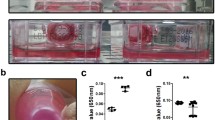Summary
Some stages in the calcification of atherosclerotic plaques may involve associations between lipids and hydroxyapatite (HA) by surface interactions. Liposomes, artifical membranous lipid vesicles, have been used in this study as model structures for biological calcification processes. Liposome (containing cholesterol and phosphatidylcholine in most cases) suspensions were prepared by sonication, after which HA seed crystals were added to the suspensions and stirred at 37°C. Aliquots of the liposome suspensions were analyzed for particle size distribution and by transmission electron microscopy and electron diffraction. The results showed that HA induced aggregation of liposomes and modifications of the microscopic shapes of the liposomes in the aggregates. These data can be explained by the electron diffraction pattern where superimposition of liposome reflection and crystal reflection exists and may suggest organic-inorganic interaction. The potential of HA crystals to induce formation of liposome aggregates may be seen as a step in atherosclerotic plaques calcification.
Similar content being viewed by others
References
Yu SY (1974) Calcification processes in atherosclerosis. Adv Exp Med Biol 43:403–425
Tanimura A, McGregor DH, Anderson HC (1986) Calcification in atherosclerosis: II. Animal studies. J Exp Pathol 2:275–297
Mora R, Lupu F, Simionescu N (1987) Prelesional events in atherogenesis. Co-localization of apoprotein B, unesterified cholesterol and extracellular phospholipid liposomes in the aorta of hyperlipidemic rabbit. Atherosclerosis 67:143–154
Chao FF, Amende LM, Blanchette-Mackie EJ, Skarlatos SI, Gamble W, Resau JH, Mergner WT, Kruth HS (1988) Unesterified cholesterol-rich lipid particles in atherosclerotic lesions of human and rabbit aortas. Am J Pathol 131:73–83
Spector M, Krokosky EM, Sax M, Pletcher J (1969) Atherosclerotic plaque: x-ray diffraction investigation. Science 165:711
Tanimura A, McGregor DH, Anderson HC (1986) Calcification in atherosclerosis: I. Human studies. J Exp Pathol 2:261–272
Maurer KH, Schumacher HR (1979) Hydroxyapatite phagocytosis by human polymorphonuclear leucocytes. Ann Rheum Dis 38:84–88
Elferink JGR (1986) Crystal-induced membrane damage: hydroxyapatite crystal-induced hemolysis of erythrocytes. Biochem Med Metab Biol 36:25–35
Wiessner J, Mandel G, Halverson P, Mandel N (1988) Membrane interaction with calcium oxalate crystals: variation in hemolytic potentials with crystal morphology. Calcif Tissue Int 42:210–219
Kozin F, Millstein B, Mandel G, Mandel N (1982) Silicainduced membranolysis: a study of different structural forms of crystalline and amorphous silica and the effects of protein adsorption. J Colloid Interface Sci 88:326–337
Weissman G, Rita GA (1972) Molecular basis of gouty inflammation: interactions of monosodium urate with lysosomes and liposomes. Nature 240:167–172
Mandel NS (1976) The molecular basis of crystal induced membranolysis. Arthritis Rheum 19:439–457
Anderson HC (1983) Calcific diseases. Arch Pathol Lab Med 107:341–348
Lerner E, Azoury R, Sarig S (1989) Rapid precipitation of apatite from ethanol-water solution. J Cryst Growth 97:725–730
Landis WJ, Glimcher MJ (1978) Electron diffraction and electron probe microanalysis of the mineral phase of bone tissue prepared by anhydrous techniques. J Ultrastruct Res 63:188–223
Huang C (1969) Studies on phosphatidylcholine vesicles. Formation and physical characteristics. Biochemistry 8:344–352
Franks NP (1976) Structural analysis of hydrated egg lecithin and cholesterol bilayer. I: x-ray diffraction. J Mol Biol 100:345–358
Chander S, Fuerstenau DW (1979) Interfacial properties and equilibria in the apatite-aqueous solution system. J Coll Interface Sci 70:506–516
Jodaikin A, Traub W, Weiner S (1985) Rat enamel: a mineralprotein relation. In: Ornay A, Harell A, Sela J (eds) Current advances in skeletogenesis. Elsevier, Amsterdam, pp 441–445
Furedi-Milhofer H, Hlady V, Baker FS, Beebe RA, Wolejko Wikholm N, Kittelberger JS (1979) Temperature-programmed dehydration of hydroxyapatite. J Coll Interface Sci 70:1–9
Hirsch D, Azoury R, Sarig S (1990) Co-crystallization of cholesterol and calcium phosphate as related to atherosclerosis. J Cryst Growth 104:759–765
Author information
Authors and Affiliations
Rights and permissions
About this article
Cite this article
Hirsch, D., Landis, W.J., Azoury, R. et al. Liposome interactions with hydroxyapatite crystals: A possible mechanism in the calcification of atherosclerotic plaques. Calcif Tissue Int 50, 261–265 (1992). https://doi.org/10.1007/BF00296291
Received:
Revised:
Issue Date:
DOI: https://doi.org/10.1007/BF00296291




